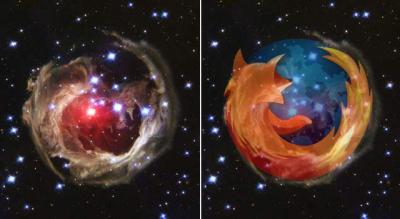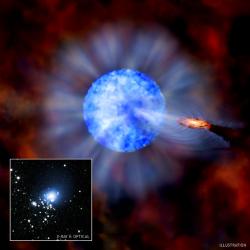Topic: Space - on April 12, 2008 at 12:44:00 PM CEST
A New Monument for Laika, Russia's Heroic Space Dog
Woof woof! Have you ever heard the story of Laika, the Soviet Space Dog? In 1957, Laika (shown above) became the first living creature to orbit the Earth, when Soviet scientists launched the 13 lb. canine into orbit aboard a hastily built Soyuz 2 space capsule. A former stray found on the streets of Moscow, Laika perished when the thermal control systems failed and the capsule overheated, killing the dog in orbit.
... Link (0 comments) ... Comment
Topic: Space - on April 12, 2008 at 12:40:00 PM CEST
Firefox Logo Spied In Deep Space
One of these is a photograph taken by the Hubble space telescope on December 17, 2002, featuring the variable star V838 Monocerotis. The other is the same photograph overlaid with a familiar logo. Can you tell which is which?

... Link (0 comments) ... Comment
Topic: Space - on January 7, 2008 at 1:21:00 PM CET
Bill Gates and Microsoft's most famous astronaut fund deep space telescope
Bill Gates and the Charles Simonyi Fund for Arts and Sciences this week donated $30 million to an ambitious telescope project that researchers say will be able to survey the entire sky every three nights - something never done before.
... Link (0 comments) ... Comment
Topic: Space - on December 20, 2007 at 4:05:00 PM CET
With bright Mars, full moon Christmas Eve, Santa could give Rudolph night off
Miami Space Transit Planetarium director Jack Horkheimer said the red planet will shine brighter because it will be directly opposite the sun, reflecting the most light, and fairly close to Earth, only 89.3 million kilometres away. The full moon will appear nearby, rising about an hour later, said Horkheimer, host of the public television show "Star Gazer."
... Link (0 comments) ... Comment
Topic: Space - on December 20, 2007 at 3:34:00 PM CET
'Active glacier found' on Mars
A probable active glacier has been identified for the first time on Mars.
The icy feature has been spotted in images from the European Space Agency's (Esa) Mars Express spacecraft.
... Link (0 comments) ... Comment
Topic: Space - on December 9, 2007 at 12:45:00 PM CET
Supercomputers Pitch in to Search for Missing Matter
I know, I know, you're probably getting sick of hearing this. Astronomers have no idea what 95% of the Universe is; 70% is dark energy, and 25% is dark matter, leaving a mere 5% normal matter. But it gets worse. Astronomers can only actually account for about 60% of that regular matter (hydrogen, helium and heavier elements) - almost half of the regular matter is missing too!
... Link (0 comments) ... Comment
Topic: Space - on November 9, 2007 at 11:59:00 AM CET
Crater From 1908 Russian Space Impact Found, Team Says
Almost a century after a mysterious explosion in Russia flattened a huge swath of Siberian forest, scientists have found what they believe is a crater made by the cosmic object that made the blast.
The crater was discovered under a lake near the Podkamennaya Tunguska River in western Siberia, where the cataclysm, known as the Tunguska event, took place.
... Link (0 comments) ... Comment
Topic: Space - on November 9, 2007 at 11:55:00 AM CET
Cosmic Recordings Double as Sci-Fi Soundtrack
Theremins in outer space! Well, almost. NASA recently published several audio recordings collected during the Cassini-Huygens space probe's exploration of the Saturnian system, and it couldn’t sound more like the soundtrack to a 2001: A Space Odyssey sequel. (And yes we know there’s already a sequel, but we mean a good sequel. Sorry, Roy Scheider. We loved you in Jaws, for serious!)
... Link (0 comments) ... Comment
Topic: Space - on November 8, 2007 at 12:09:00 PM CET
NASA satellites to predict and prevent infectious disease outbreaks
NASA and its Applied Sciences Program will be using 14 satellites to watch the Earth’s environment and help predict and prevent infectious disease outbreaks around the world.
Through orbiting satellites, data is collected daily to monitor environmental changes. That information is then passed on to agencies such as the Centers for Disease Control and Prevention and the Department of Defense who then apply the data to predict and track disease outbreaks and assist in making public health policy decisions. The use of remote sensing technology helps scientists predict the outbreak of some of the most common and deadly infectious diseases such as Ebola, West Nile virus and Rift Valley Fever.
... Link (0 comments) ... Comment
Topic: Space - on October 22, 2007 at 5:08:00 PM CEST
How to build your own Sputnik
It seems incredible that the technology that went into building the first successful satellite 50 years ago can now be found lying around the average house. You could even build one yourself, as Paul Rubens explains below. Fancy having a go? Then, sign up to the Magazine's Sputnik Challenge at the bottom of this page.
... Link (0 comments) ... Comment
Topic: Space - on October 19, 2007 at 12:37:00 PM CEST
Heaviest Stellar Mass Black Hole Discovered
Black holes come in two varieties: supermassive and stellar. The supermassive variety can have millions of times the mass of a star, while the stellar varieties are usually just a few times the mass of a single sun. Using the Chandra X-Ray Observatory, astronomers have turned up the most massive stellar mass black hole ever seen, weighing in at 15.7 times the mass of the Sun, lurking in a nearby galaxy.

... Link (0 comments) ... Comment
Topic: Space - on October 17, 2007 at 12:25:00 PM CEST
Oct. 17, 1604: Johannes Kepler Goes Dancing With a Star
The German astronomer was not the first to see the star -- several others had identified it a week earlier and one, John Brunowski, actually alerted him to its presence -- but Kepler's systematic observations were so detailed that the body became known as Kepler's star (or Kepler's supernova).

... Link (0 comments) ... Comment










